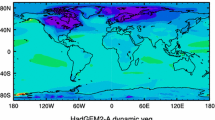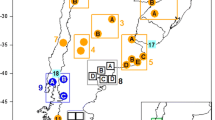Abstract
Various proxy data reveal that in many regions of the Northern Hemisphere (NH), the middle Holocene (6 kyr BP) was warmer than the early Holocene (8 kyr BP) as well as the later Holocene, up to the end of the pre-industrial period (1800 AD). This pattern of warming and then cooling in the NH represents the response of the climate system to changes in orbital forcing, vegetation cover and the Laurentide Ice Sheet (LIS) during the Holocene. In an attempt to better understand these changes in the climate system, the McGill Paleoclimate Model (MPM) has been coupled to the dynamic global vegetation model known as VECODE (see Part I of this two-part paper), and a number of sensitivity experiments have been performed with the “green” MPM. The model results illustrate the following: (1) the orbital forcing together with the vegetation—albedo feedback result in the gradual cooling of global SAT from about 6 kyr BP to the end of the pre-industrial period; (2) the disappearance of the LIS over the period 8–6 kyr BP, associated with vegetation—albedo feedback, allows the global SAT to increase and reach its maximum at around 6 kyr BP; (3) the northern limit of the boreal forest moves northward during the period 8–6.4 kyr BP due to the LIS retreat; (4) during the period 6.4–0 kyr BP, the northern limit of the boreal forest moves southward about 120 km in response to the decreasing summer insolation in the NH; and (5) the desertification of northern Africa during the period 8–2.6 kyr BP is mainly explained by the decreasing summer monsoon precipitation.
















Similar content being viewed by others
Notes
In Wang and Mysak (2002), the atmospheric variables such as SAT, surface specific humidity, and precipitation are downscaled to 5°×5° in the region 30°N to 75°N
Thermal gradient is defined as the SAT in the Sahara minus the SAT in tropical Atlantic
References
COHMAP (1988) Climatic changes of the last 18,000 years: observations and model simulations. Science 241:1043–1052
TEMPO (1996) Potential role of vegetation feedback in the climate sensitivity of high-latitude regions: a case study at 6000 years BP. Global Biogeochem Cy 10(4):727–736
Anderson PM, Brubaker LB (1994) Vegetation history of northcentral Alaska: a mapped summary of Late-Quaternary pollen data. Quaternary Sci Rev 13:71–92
Barber DC et al (1999) Forcing of the cold event of 8,200 years ago by catastrophic drainage of Laurentide lakes. Nature 400:344–348
Bard E, Hamelin B, Fairbanks RG, Zindler A (1990) Calibration of the 14C timescale over the past 30,000 years using mass spectrometric U–Th ages from Barbados corals. Nature 345:405–410
Bauer E, Ganopolski A, Montoya M (2004) Simulation of the cold climate event 8,200 years ago by meltwater outburst from Lake Agassiz. Paleoceanography 19: PA3014; doi:10.1029/2004PA001030
Berger AL (1978) Long-term variations of daily insolation and Quaternary climatic changes. J Atmos Sci 35:2362–2367
Bigelow NH et al (2003) Climate change and Arctic ecosystems: 1. Vegetation changes north of 55°N between the last glacial maximum, mid-Holocene, and present. J Geophys Res 108(D19): 8170; doi:10.1029/2002JD002558
Bonan GB, Pollard D, Thompson SL (1992) Effects of boreal forest vegetation on global climate. Nature 359:716–718
Brovkin V, Bendtsen J, Claussen M, Ganopolski A, Kubatzki C, Petoukhov V, Andreev A (2002) Carbon cycle, vegetation and climate dynamics in the Holocene: experiments with the CLIMBER-2 Model. Global Biogeochem Cy 16(4):1139; doi:10.1029/2001GB001662
Brovkin V, Levis S, Loutre M-F, Crucifix M, Claussen M, Ganopolski A, Kubatzki C, Petoukhov V (2003) Stability analysis of the climate-vegetation system in the northern high latitudes. Climatic Change 57(1):119-138
Charney J, Stone PH, Quirk WJ (1975) Drought in Sahara-biogeophysical feedback mechanism. Science 187:434–435
Charney J, Quirk WJ, Chow SH, Kornfield J (1977) A comparative study of the effects of albedo change on drought in semi-arid regions. J Atmos Sci 34:1366–1385
Claussen M, Kubatzki C, Brovkin V, Ganopolski A, Hoelzmann P, Pachur HJ (1999) Simulation of an abrupt change in Saharan vegetation in the mid-Holocene. Geophys Res Lett 24(14):2037–2040
Crucifix M, Loutre MF, Tulkens P, Fichefet T, Berger A (2002) Climate evolution during the Holocene: a study with an Earth system model of intermediate complexity. Clim Dyn 19:43–60
Davydova NN, Delusina IV, Subetto DA (1992) Boltshezemeltskaya tundra. In: Davydova NN (ed) Istoriya ozer Tostochno-Evropeiskoi Ravniny Nauka, St. Petersburg, pp 34–45
deMenocal P, Ortiz J, Guilderson T, Sarnthein M (2000a) Coherent high- and low-latitude climate variability during the Holocene warm period. Science 288:2198–2202
deMenocal P, Ortiz J, Guilderson T, Adkins J, Sarnthein M, Baker L, Yarusinski M (2000b) Abrupt onset and termination of the African humid period: rapid climate response to gradual insolation forcing. Quaternary Sci Rev 19:341–361
Dyke AS, Prest VK (1986) Late Wisconsinan and Holocene retreat of the Laurentide Ice Sheet. Geological Survey of Canada, Map 1702A, 1:5,000,000
Dyke AS, Prest VK (1987) Late Wisconsinan and Holocene history of the Laurentide Ice Sheet. Geogr Phys Quatern 41:237–264
Edwards ME, Barker ED (1994) Climate and vegetation in northeastern Alaska 18,000 yr BP. Palaeogeogr Palaeoclim Palaeoecol 109:127–135
Enzel Y et al (1999) High-resolution Holocene environmental changes in the Thar desert, northwestern India. Science 284:125–128
Fairbanks RG (1989) A 17,000-year glacio-eustatic sea level record: influence of glacial melting rates on the Younger Dryas event and deep-ocean circulation. Nature 342:637–642
Ganopolski A, Kubatzki C, Claussen M, Brovkin V, Petoukhov V (1998) The influence of vegetation-atmosphere-ocean interaction on climate during the mid-Holocene. Science 280:1916–1919
Gasse F (2000) Hydrological changes in the African tropics since the Last Glacial Maximum. Quaternary Sci Rev 19:189–211
Grootes PM, Stuiver M, White JWC, Johnsen S, Jouzel J (1993) Comparison of oxygen isotope records from the GISP2 and GRIP Greenland ice cores. Nature 366:552–554
Hall NMJ, Valdes PJ (1997) A GCM simulation of the climate 6000 years ago. J Climate 10:3–17
Harvey LDD (1988) On the role of high latitude ice, snow and vegetation feedbacks in the climatic response to external forcing changes. Climatic Change 13:191–224
Hoelzmann P, Jolly D, Harrison SP, Laarif F, Bonnefille R, Pachur HJ (1998) Mid-Holocene land-surface conditions in northern Africa and the Arabian Peninsula: a data set for the analysis of biogeophysical feedbacks in the climate system. Global Biogeochem Cy 12:35–52
Hu FS et al (1999) Abrupt changes in North American climate during early Holocene times. Nature 400:437–440
Joos F, Gerber S, Prentice IC, Otto-Bliesner BL, Valdes PJ (2004) Transient simulation of Holocene atmospheric carbon dioxide and terrestrial carbon since the Last Glacial Maximum. Global Biogeochem Cy 18; doi:10.1029/2003GB002156
Kutzbach JE (1981) Monsoon climate of the early Holocene: climatic experiment using the Earth’s orbital parameters for 9000 years ago. Science 214:59–61
Kutzbach JE, Liu Z (1997) Response of the African monsoon to orbital forcing and ocean feedbacks in the middle Holocene. Science 278:440–443
Kutzbach JE, Otto-Bliesner BL (1982) The sensitivity of the African-Asian monsoonal climate to orbital parameter changes for 9000 years B.P. in a low-resolution general circulation model. J Atmos Sci 39(6):1177–1188
Kutzbach J, Bonan G, Foley J, Harrison SP (1996) Vegetation and soil feedbacks on the response of the African monsoon to orbital forcing in the early to middle Holocene. Nature 384:623–626
Lamb HF, Edwards ME (1988) The Arctic. In: Huntley B, Webb T III (eds) Vegetation history. Kluwer, Dordrecht, pp 519–555
Levitus S (1982) Climatological Atlas of the World Ocean. Technical report, NOAA Professional Paper 13US Government Printing Office, Washington, DC
Liu Z, Otto-Bliesner B, Kutzbach J, Li L, Shields C (2003) Coupled climate simulation of the evolution of global monsoons in the Holocene. J Climate 16:2472–2490
MacDonald GM et al (2000) Holocene treeline history and climate change across Northern Eurasia. Quaternary Res 53:302–311; doi:10.1006/qres.1999.2123
Mitchell J, Grahame N, Needham K (1988) Climate simulation for 9000 years before present: seasonal variations and effect of the Laurentide Ice Sheet. J Geophys Res 93(D7):8283–8303
de Noblet N, Braconnot P, Joussaume S, Masson V (1996) Sensitivity of simulated Asian and African summer monsoons to orbitally induced variations in insolation 126, 115 and 6 kBP. Clim Dyn 12:589–603
Paterson WSB (1972) Laurentide Ice Sheet: estimated volumes during Late Wisconsin. Rev Geophys Space Phys 10:885–917
Pollard D, Bergengren J, Stillwell-Soller L, Felzer B, Thompson S (1998) Climate simulations for 10000 and 6000 years BP using the GENESIS global climate model. Palaeoclimates 2:183–218
Prentice IC, Jolly D et al (2000) Mid-Holocene and glacial-maximum vegetation geography of the northern continents and Africa. J Biogeogr 27:507–519
Prentice IC, Webb T (1998) BIOME 6000: reconstructing global mid-Holocene vegetation patterns from palaeoecological records. J Biogeogr 25:997–1005
Prentice IC, Guiot J, Huntley B, Jolly D, Cheddadi R (1996) Reconstructing biomes from palaeoecological data: a general method and its application to European pollen data at 0 and 6 ka. Clim Dyn 12:185–194
Renssen H, Goosse H, Fichefet T, Campin JM (2001) The 8.2 kyr BP event simulated by a global atmosphere-sea-ice-ocean model. Geophys Res Lett 28(8):1567–1570
Renssen H, Brovkin V, Fichefet T, Goosse H (2003) Holocene climate instability during the termination of the African Humid Period Geophys Res Lett 30(4):1184; doi:10.1029/2002GL016636
Richard PJH (1995) Le couvert végétatal du Québec-Labrador il ya 6000 ans BP: Essai. Geogr Phys Quatern 49:117–140
Ricketts RD et al (2001) The Holocene paleolimnology of Lake Issyk-Kul, Kyrgyzstan: trace element and stable isotope composition of ostracodes. Palaeogeogr Palaeocl Palaeoecol 176:207–227
Ritchie JC (1987) The postglacial vegetation of Canada. Cambridge University Press, New York, 187 pp
Ritchie JC, MacDonald GM (1986) The patterns of post-glacial spread of white spruce. J Biogeogr 132:527–540
Ruddiman WF (2000) Earth’s climate: past and future. W.H. Freeman and Company, New York
Staubwasser M, Sirocko F, Grootes PM, Segl M (2003) Climate change at the 4.2 ka BP termination of the Indus valley civilization and Holocene south Asian monsoon variability. Geophys Res Lett 30(8):1425; doi:10.1029/2002GL016822
Street-Perrott FA (1979) Late Quaternary precipitation estimates for the Ziway-Shala Basin, Southern Ethiopia. Palaeoecol Africa 11:135–143
Street-Perrott FA, Grove AT (1979) Global maps of lake-level fluctuations since 30,000 yr BP. Quaternary Res 12:83–118
Street-Perrott FA, Perrott RA (1993) Holocene vegetation lake levels and climate of Africa. In: Wright HE et al (eds) Global climates since the Last Glacial Maximum. University of Minnesota Press, Minneapolis, pp 318–356
Texier D, de Noblet N, Harrison S, Haxeltine A, Jolly D, Joussaume S, Laarif F, Prentice IC, Tarasov P (1997) Quantifying the role of biosphere-atmosphere feedbacks in climate change: coupled model simulations for 6000 years BP and comparison with palaeodata for northern Eurasia and northern Africa. Clim Dyn 13:865–882
Thompson LG et al (2002) Kilimanjaro ice core records: evidence of Holocene climate change in tropical Africa. Science 298:589–593
Velichko AA, Andreev AA, Klimanov VA (1997) Climate and vegetation dynamics in the tundra and forest zone during the late glacial and Holocene. Quatern Int 41/42:71–96
Wang Z, Mysak LA (2000) A simple coupled atmosphere-ocean-sea ice-land surface model for climate and paleoclimate studies. J Climate 13:1150–1172
Wang Z, Mysak LA (2002) Simulation of the last glacial inception and rapid ice sheet growth in the McGill paleoclimate model. Geophys Res Lett 29(23): 2102; doi:10.1029/2002GL015120
Wang Y, Mysak LA, Wang Z, Brovkin V (2005) The greening of the McGill Paleoclimate Model. Part I: improved land surface scheme with vegetation dynamics. Clim Dyn (in press)
Acknowledgements
This work was supported by a Project Grant from CFCAS and a Discovery Grant from NSERC of Canada awarded to L.A.M. We appreciate the helpful discussions we had with Drs. Thomas F. Pedersen, Thomas C. Johnson, and Garry Clarke throughout the course of this work. We thank COHMAP and TEMPO members for providing intercomparison vegetation data. The Laurentide Ice Sheet data were kindly provided by Dr. Arthur S. Dyke from the Geological Survey of Canada. The comments of the three anonymous referees which helped to improve this paper, and the editorial assistance of Rebekah Kipp are gratefully acknowledged.
Author information
Authors and Affiliations
Corresponding author
Rights and permissions
About this article
Cite this article
Wang, Y., Mysak, L.A., Wang, Z. et al. The greening of the McGill Paleoclimate Model. Part II: Simulation of Holocene millennial-scale natural climate changes. Clim Dyn 24, 481–496 (2005). https://doi.org/10.1007/s00382-004-0516-8
Received:
Accepted:
Published:
Issue Date:
DOI: https://doi.org/10.1007/s00382-004-0516-8




